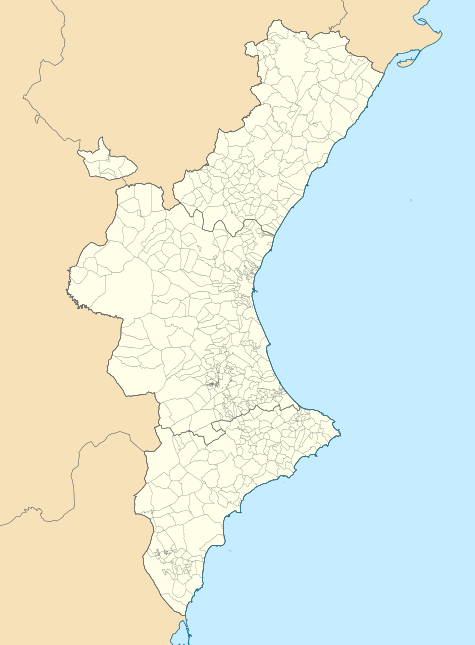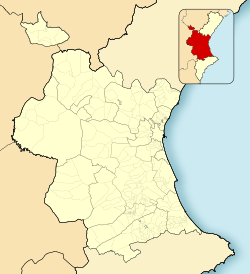Cullera
Cullera (Valencian pronunciation: [kuˈʎeɾa]) is a city and municipality of Spain located in the Valencian Community. It is part of the province of Valencia and the Ribera Baixa comarca. The city is placed near the discharge of the Júcar in the Mediterranean Sea.
Cullera | |
|---|---|
 | |
 Flag  Coat of arms | |
 Cullera Location in Spain  Cullera Cullera (Valencian Community)  Cullera Cullera (Province of Valencia) | |
| Coordinates: 39°9′50″N 0°15′6″W | |
| Country | Spain |
| Autonomous community | Valencian Community |
| Province | Valencia |
| Comarca | Ribera Baixa |
| Government | |
| • Alcalde | Jordi Mayor |
| Area | |
| • Total | 53.8 km2 (20.8 sq mi) |
| Elevation | 2 m (7 ft) |
| Population (2018)[1] | |
| • Total | 21,918 |
| • Density | 410/km2 (1,100/sq mi) |
| Demonym(s) | Cullerenc, cullerenca Cullerà, cullerana |
| Time zone | UTC+1 (CET) |
| • Summer (DST) | UTC+2 (CEST) |
| Postal code | 46400 |
| Website | Official website |
Geography
Cullera is situated at the mouth of the Júcar river, 40 km from the capital of Valencia and 56 km from the international airport of Valencia aeropuerto de manises. Cullera is a very famous town in the COMUNIDAD VALENCIANA with a great tourist attraction. especially, the medusa medusa festival. Cullera is very famous town on the name of medusa festival. last year [2019] medusa festival had a great attraction of more than 3,25,000 tourists. Cullera has many sites and spots to visit. This town has mountains, along with river jucar {also known as rio xuquer in valenciano]river xuquer or jucar and the most visited place is beach of cullera {playa de cullera}
areas in cullera and hamlets
The parts and areas of Cullera are:
- El Brosquil.
- Cullera-Park.
- Cap-Blanc.
- El Dosel.
- El Estany.
- El Marenyet.
- Mareny de San Lorenzo.
- Mareny Blau.
- Bega de Mar,
- El Perelló,
Topography
The mountain of Cullera, known as Munt de l'Or or Muntanya de l'Or, is the last mountain in the Iberian System before the Mediterranean Sea. It has an altitude of 233 meters. The historical parts of the city are to the south, and the modern tourist district is to the east, looking to the sea.There is a great view from the mountains of cullera. it has a castillo[an old church]about the castillo and radar. A Number of people come for mountain climbing and cycling on the mountains of cullera.
The San Lorenzo lagoon is a small lake situated north of the mountain. It once formed part of a much bigger lake before the lands were drained for agricultural use. The lake now marks the southern limit of the Parque Natural de la Albufera.
Demographics
| 1990 | 1992 | 1994 | 1996 | 1998 | 2000 | 2002 | 2004 | 2006 | 2008 | 2010 |
|---|---|---|---|---|---|---|---|---|---|---|
| 20.927 | 20.336 | 20.663 | 20.595 | 20.397 | 20.663 | 20.622 | 22.544 | 23.619 | 23.777 | 23.813 |
Economy
The economy in Cullera is traditionally based in agriculture, with rice and oranges as important crops. Fishing, historically a large part of the economy, has diminished in importance due to important tourism developments, both nationally and internationally, in the region.
Historical and artistic landmarks
- Castle: At the top of the mountain, dominating the city and the sea, there is a fortress built in the 13th century over the old Moorish fortress. It once was walled, although those walls no longer remain. Located there are the rest of the old towers, forming part of the old walled area on the mountain.[3]
- Sanctuary of the Virgen del Castillo: (19th century) Within the fortress, there is the sanctuary of the Virgen del Castillo, whose festival is celebrated the week after Passover.
- Church of the Saint Johns: A neoclassical temple from the 17th century built over an older Gothic temple. Inside, there is a sacristía and the interior of a bell tower. The temple has recently been restored.[4]
- Torre del marenyet: An old watchtower built to watch the Júcar river. It was erected in the 15th century as a defense against barbary pirates.[5]
- Cave of Dragut: This cave depicts the invasion of the Berbers in Cullera, and it is said that the pirate Dragut was once there.[6][7]
- Air-raid shelter-Museum of the Mercat Municipal: A bomb shelter constructed under the Town's Market under the threat of air bombing during the Spanish Civil War.[8]
- Hermitage of the stone saints (Abdon and Sennen): The building, situated on a hill surrounded by rice crops, was dedicated to these saints because they are related to the welfare of the crops. Nowadays, the Hermitage, which was built in the 18th century, has been reconverted into a museum dedicated to rice, from species to crops and tools, which is very important for Valencian cuisine.[9]
- Abric Lambert cave paintings: Named after its discoverer Lambert Oliver, the Abric Lambert is located in the north-west side of the mountain. The paintings are several figures painted in a dark red shade with cruciforms and comb-shaped figures that have been interpreted as animal and human figures.[10]
Food
The typical food of the region is the so-called Mediterranean diet, which is characterized by a rich selection of vegetables. In Cullera's orchards, there are many citrus crops (oranges, mandarins and lemons), as well as fish and seafood of the nearby sea. Alongside the offerings of the orchards, not to mention the seafood, there are dozens of ways to prepare rice: arroz al horno, arroz a banda, etc.
Twin towns




See also
References
- Municipal Register of Spain 2018. National Statistics Institute.
- "Ficha municipal Cullera" [Municipal sketch Cullera] (PDF) (in Spanish). Institut valencià d'estadística. 2011. p. 1. Retrieved 13 May 2012.
- "El Castillo" (in Spanish). Cullera Turismo. Archived from the original on 21 August 2012. Retrieved 13 May 2012.
- "Parish Church of Los Santos Juanes". Cullera Turismo. Archived from the original on 19 March 2014. Retrieved 13 May 2012.
- "Marenyet Tower". Cullera Turismo. Archived from the original on 19 March 2014. Retrieved 13 May 2012.
- "Museum". Cueva del Dragut. Retrieved 17 April 2012.
- "Museo Temático de la Piratería Cueva-Museo del Pirata Dragut". Cullera Turismo. Archived from the original on 20 March 2014. Retrieved 17 April 2012.
- "Refugio-Museo del Mercado Municipal" (in Spanish). Cullera Turismo. Archived from the original on 19 March 2014. Retrieved 17 April 2012.
- "Museo Temático-Museo del Arroz" (in Spanish). Cullera Turismo. Archived from the original on 20 March 2014. Retrieved 5 August 2012.
- "'Abric Lambert' Cave Paintings". Cullera Turismo. Archived from the original on 17 March 2014. Retrieved 14 December 2013.
- "Twin cities monument". Retrieved 17 April 2012.
External links
| Wikimedia Commons has media related to Cullera. |
| Wikivoyage has a travel guide for Cullera. |
- Instituto Valenciano de Estadística
- Castillo de Cullera
- https://web.archive.org/web/20060204235358/http://www.costamediterranea.com/dondeir/valencia/cullera.html
- http://www.valencians.com/valencia/rb/cullera
![]()
